Google Nexus 5 Review
by Brian Klug on December 5, 2013 8:00 AM EST- Posted in
- Smartphones
- LG
- Android
- Mobile
- Snapdragon 800
- Android 4.4
- Nexus 5
It goes without saying that battery life is one of the huge cornerstones of smartphone evaluation and critique. In the case of Nexus 5, the battery is a 3.8 V, 2300 mAh 2D battery giving 8.74 watt hours total. Looking only at battery capacity doesn’t always tell the whole story, since obviously it’s just a tank to draw from – the overall efficiency of the entire system and the sum of the energy drain of its parts determines how long the platform will last. The comparison point of course for the Nexus 5 is its close cousin, the LG G2, which has a 3000 mAh (11.4 Whr) stacked (3D) battery by LG Chem. Smartphone battery sizes have been increasing for a while now, and the reality is that Nexus 5’s is indeed on the smaller side given its display.
As I’ll talk about later, one thing the Nexus 5 has over the LG G2 is a QFE1100 envelope tracker for its cellular power amplifiers, which lowers power consumption by up to 20 percent, the same RF360 part we saw in the Galaxy Note 3. Interestingly enough the LG G2 shipped with a variant of this same family, QFE1101, which works in an APT (Average Power Tracker) mode instead, whereas QFE1100 works in both APT and ET modes. I’ll touch on these in the relevant section, but it’s important to note that in the cellular tests one of the big consumers of power (power amplifiers are easily the number two after display) has the bleeding edge component available to curb consumption and is literally the second handset on the market to include it.
To evaluate battery life we turn to our battery life testing suite, which we run over WiFi and all the cellular interfaces appropriate for the device. Here we see a good combination of regular spikes in CPU usage with idle time, hopefully simulating constant, reasonably paced usage. As always the display is set to exactly 200 nits and configured the same way we always configure devices for maximum consistency.

On WiFi, we see the Nexus 5 start off pretty well, behind the G2 and the newest 8974 phones, but no slouch at all, and considerably better than the Nexus 4. Of interest is how the Nexus 5 slips 16 percent versus the G2 despite having a 23 percent smaller battery.
For cellular, it’s the same workload as always. Since the Nexus 5 now has LTE, I went back and re-tested the Nexus 4 with LTE enabled for a closer comparison. Although the Nexus 4 never shipped with LTE officially enabled, the device included it on Band 4 for some time until a baseband update finally locked it out for good. I flashed back down and ran the test just for the sake of completeness, and since I Know there are a fair amount of people out there using the Nexus 4 on LTE still. Of course I also tested on 3G WCDMA.
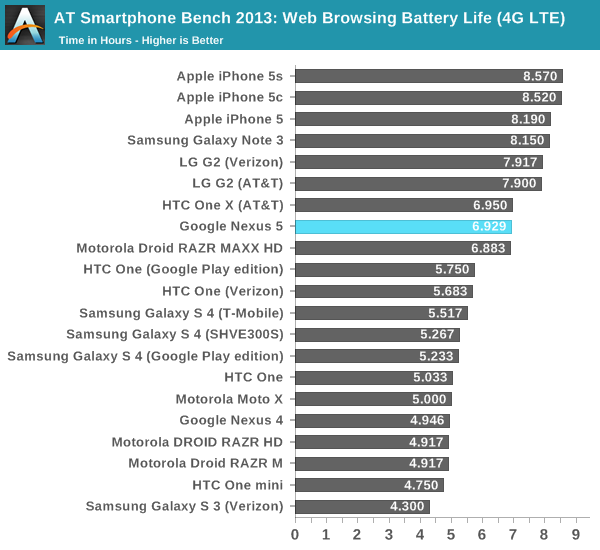

The Nexus 5 comes out far ahead of its predecessor on both 3G WCDMA and 4G LTE, although that’s fairly unsurprising given the year of improvement, different process (28nm HPM), envelope tracking, and battery size differences. The more interesting comparison point is the LG G2, which Nexus 5 can’t quite catch. Clearly the RF front end differences make a difference, otherwise the scaling would be 23 percent less battery on cellular, instead it is 12 percent on LTE. On 3G there’s a bigger delta however, almost 33 percent worse than the G2’s impressive result. Still, the Nexus 5 on LTE is no slouch.
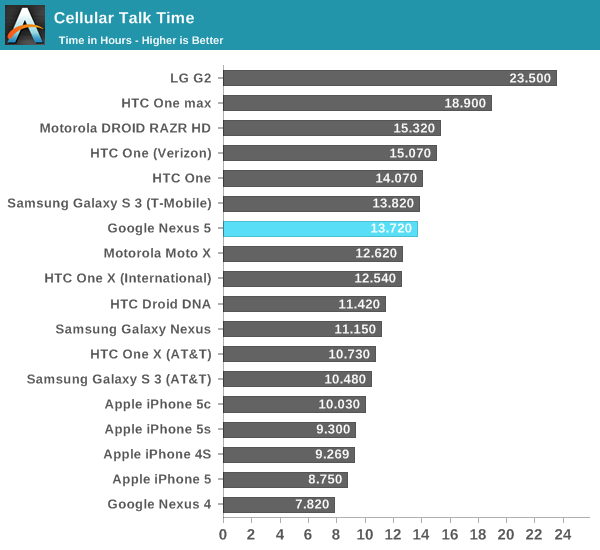
In the talk time test I was surprised to see a considerable falloff, although this is almost always gated by rock bottom power for the system. There clearly are some other consumers which either aren’t powering down all the way or LG has better optimized for on the G2 versus the Nexus 5 which is Google’s domain.
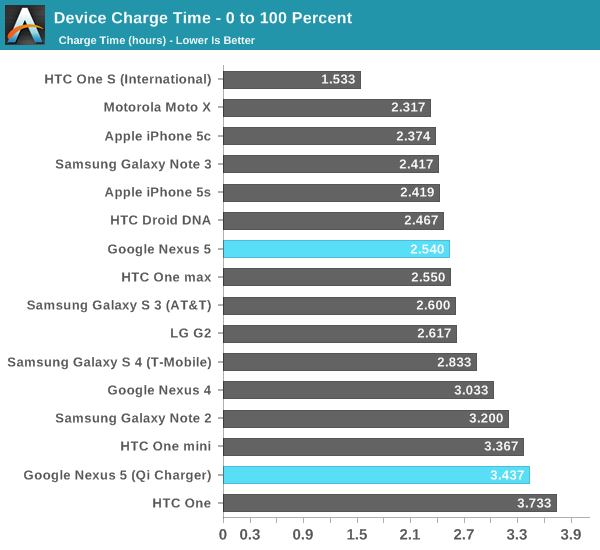
Looking at battery capacity alone would leave you with the impression that the Nexus 5 is woefully under-specced, when in reality battery life shows definite gains over previous generation devices. Although I’d love if the device somehow had the same size battery as the G2, it’s clearly enough to make it through at least a full day, and in my time daily driving the device I’ve yet to come up short.
When it comes to charging, Google continues to do the sane thing and implement BC 1.2 signaling. Unlike the LG Optimus G, the Nexus 5 does not use the battery charging IC Qualcomm makes for use in conjunction with its normal PMICs, instead it uses the TI BQ24192 to charge at up to 1.5 A maximum and a MAX17048 fuel gauge. This seems to be done in order to accommodate wireless charging, though there could be other cost considerations at play. The Nexus 5 seems to charge in the linear region at just above 1 A however, although the limit set for BQ24192 is 1.5 A, and has a total charge time just above 2.5 hours on the supplied 1.2 A charger.
As I mentioned, Nexus 5 also works with the Qi (prounounced “chee”) wireless charging specification which Google seems to have thankfully settled on for Nexus 4, 7, and now 5. The Nexus 5 uses TI’s bq51013b power supply and charge receiver which is WPC 1.1 compliant. I praised the Nexus 4 for how well implemented Qi charging was and how it charged in basically the same amount of time on the charging mat or USB, as far as I can tell the Nexus 5 continues to implement things properly and will charge at accelerated rates. I’ve seen a few handsets that include Qi but oddly enough only charge at 500 mA like a USB data port, this is thankfully not the case on Nexus 5.
Nexus Wireless Charger
Google sent along their first party Qi wireless charger as well and I had a chance to check it out. I’ve never used the charging “Orb” that shipped with Nexus 4 so I can’t comment on it, I have however used the two-position Energizer Qi charger and the Samsung Qi charger pad. Google’s universal Nexus wireless charger works with the other Qi compatible Nexus devices, Nexus 7 (2013), 4, and 5, and of course any Qi compliant devices. I tested with the Droid DNA and had no issues charging like any other Qi charger.
Google’s charger works in conjunction with a 9 Watt USB AC adapter and plugs into the charging puck over microUSB. What’s interesting about the charger is both how small it is (the outline is quite small) and how the bottom has a material that seems eerily reminiscent of what was on the bottom of the touchstone charger that shipped with the Palm Pre. The charger will securely adhere itself to surfaces, which it needs to since it has some magnets inside for alignment of devices.
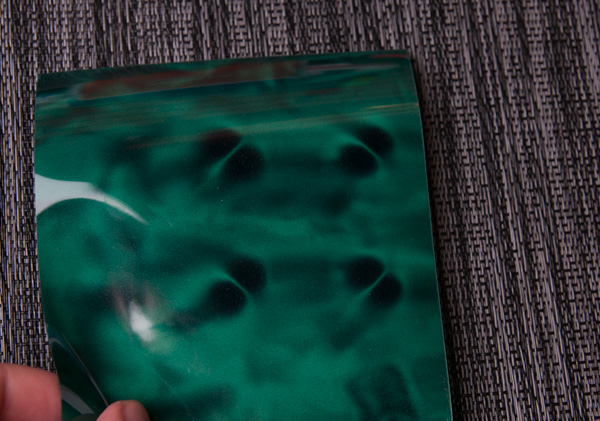
I put some magnetic field viewing film on top of Google’s wireless charger, and you can see four magnets at the corners, which match up nicely with the four metal slugs on the back of the Nexus 5 around the charging coil.
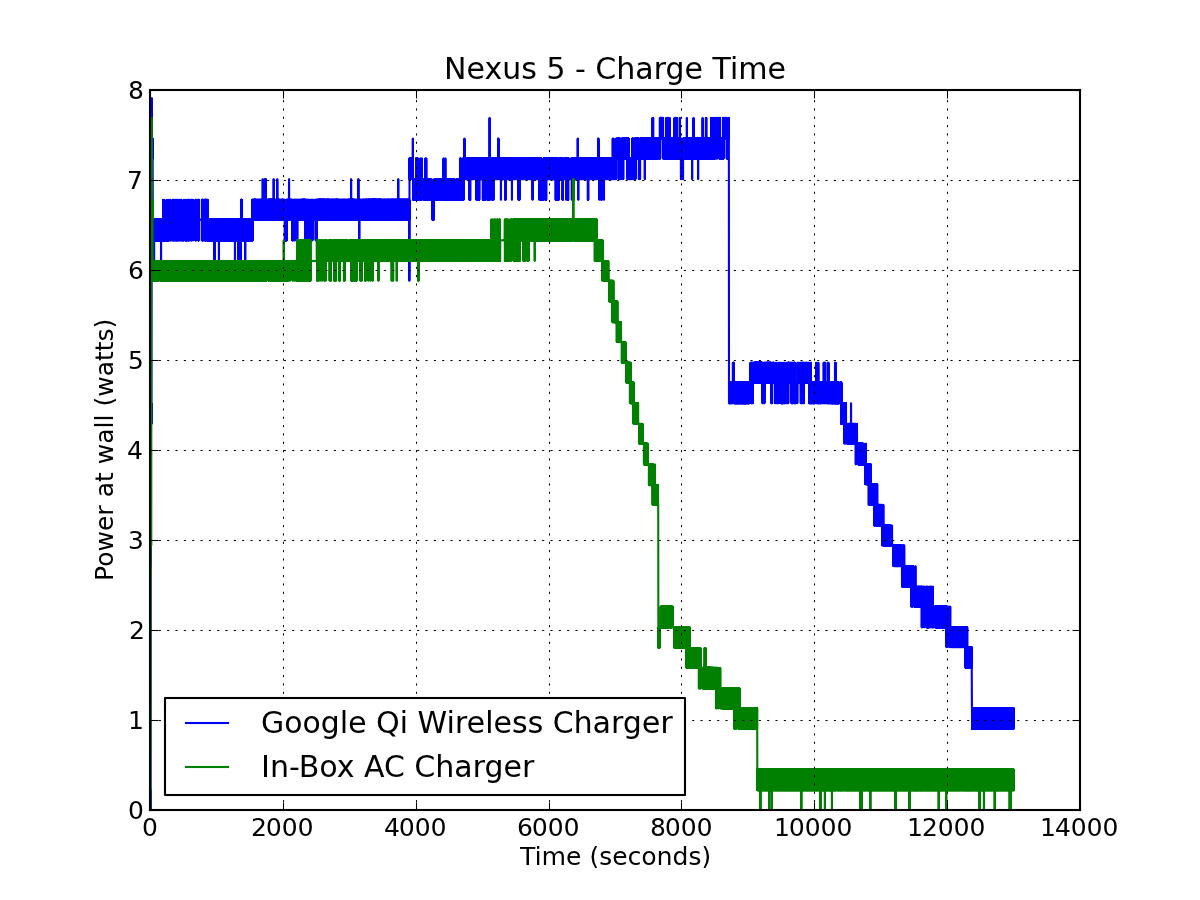
There’s still some overhead and loss with all wireless charging, including Qi. I measured and plotted the power draw and thus charge time for a fully drained Nexus 5 being charged both using the in-box supplied AC charger from Google, and their wireless charger. There ends up being about a 50 minute difference between the two, so you’re definitely trading convenience for a longer charge time, but once you’ve used wireless charging it’s hard to give up that convenience. At the very least, Google’s new charger addresses some of the complaints I saw levied against the original charging Orb with the inclusion of magnets that do seem to hold down devices better and keep them aligned so they charge properly, and included a very good grippy material on the back that adheres it to surfaces quite nicely.


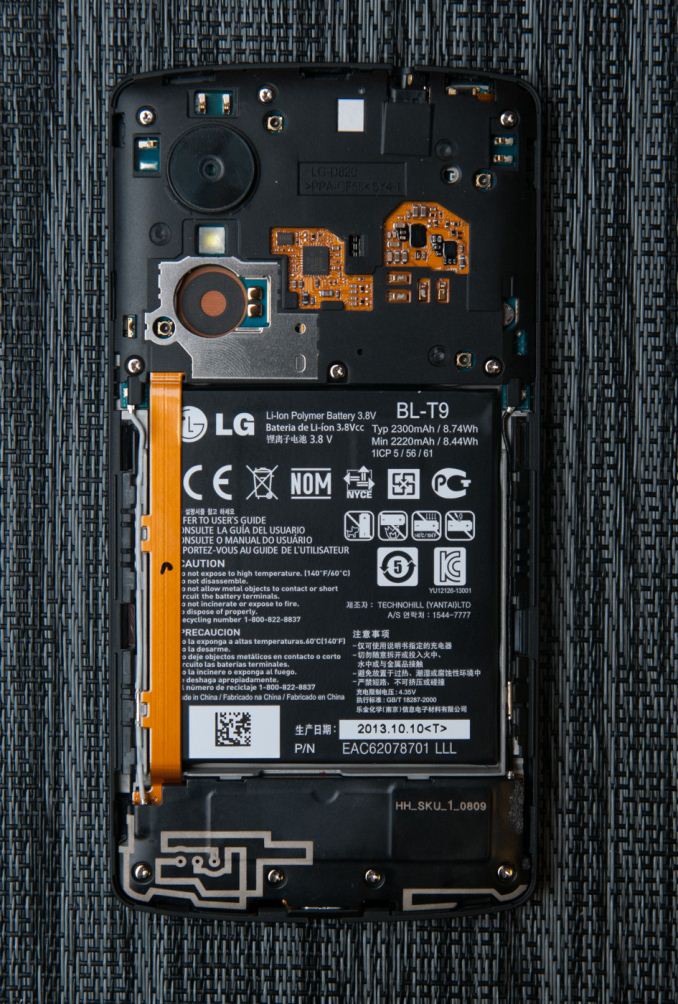
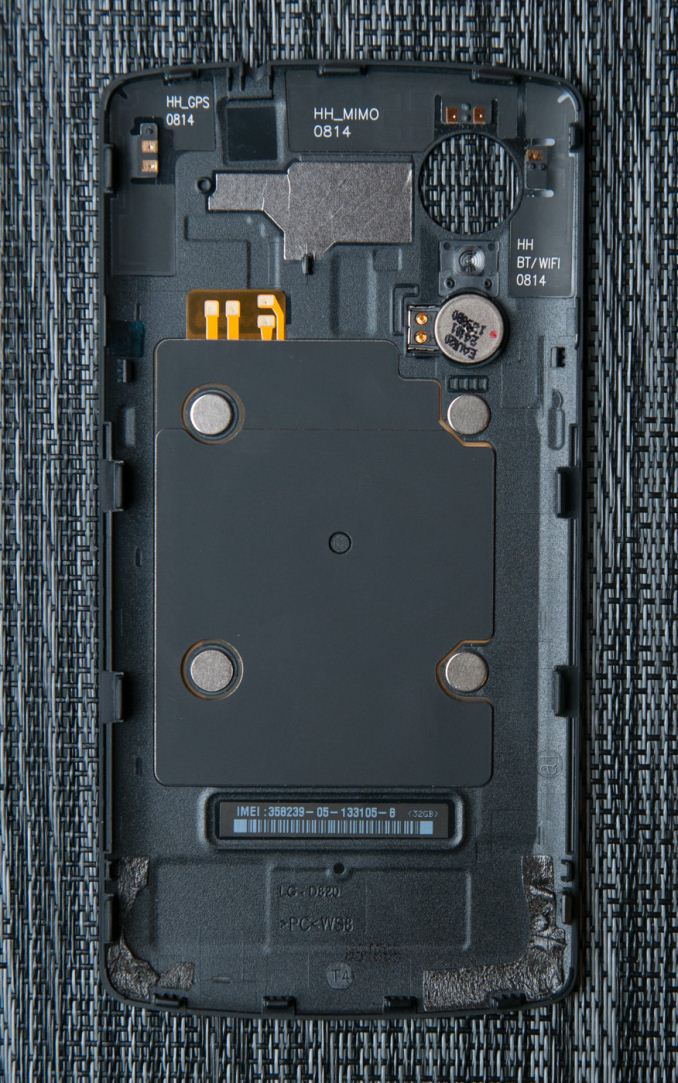
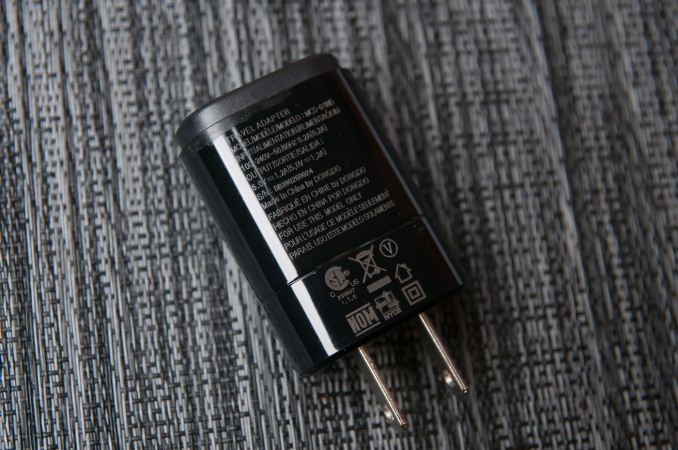
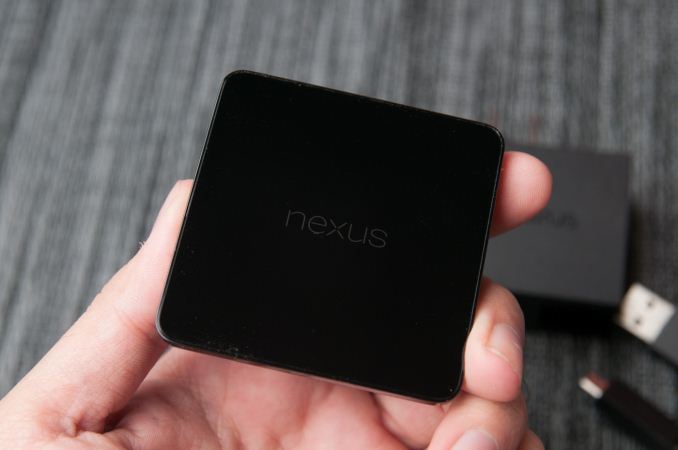














231 Comments
View All Comments
rwei - Thursday, December 5, 2013 - link
>nobody has still been able to merge the two together the same way WebOS did with the Palm PreWP does a good enough job interleaving and integrating the two that I'm almost completely agnostic over whether I use SMS, Facebook or MSN/Skype, and switch between them seamlessly based on my iOS/Android recipients' preferences.
PsychoPif - Thursday, December 5, 2013 - link
I really love AnandTech, but I find the fact that they act like Windows Phones does'nt exist quite disturbing.I see 18 device on the battery chart, but not one runs WP8.
kyuu - Thursday, December 5, 2013 - link
Brian Klug seems to have a personal beef with Windows Phone and, apparently, refuses to review them.hrrmph - Thursday, December 5, 2013 - link
I have one sitting here in front of me (a Samsung ATIV-S that I bought on the cheap to play with).So let me point out that out of the 4 devices (3 operating systems and as many manufacturers) that I use, it is the only one that cannot handle my complete collection of music files (it chokes on FLAC files).
So after 20 years of making about 40 billion dollars a year, Microsoft cannot bring themselves to support the leading open standard for high quality 24-bit loss-less audio files?
munim - Friday, December 6, 2013 - link
Probably because it's useless to have such high fidelity support on a mobile device that you'll be using outside of a studio.Impulses - Friday, December 6, 2013 - link
Yeah, I'm surprised there's so many mentions of FLAC thru the comments... It's almost ironic, I really hope none of the people pinning for FLAC support are the same ones complaining about removable storage!My entire CD collection is ripped to FLAC, it just makes the most sense got archival purposes, I wish more mainstream music was available in lossless formats just out of principle... However it's pretty pointless to be dragging FLAC files around on a phone.
You're not gonna be able to tell the difference vs properly encoded MP3s, even if you're traveling with $300+ worth of DAC/amp equipment and $500+ reference grade headphones or IEM (much less the kinda headphones most people use, never mind the line out or Bluetooth which would pose the weakest link in the chain).
Do a proper blind test, then try to rationalize why FLAC support is so important... Considering it takes no time at all to convert a big library and it's gonna take up a fraction of the space your FLAC library already does (I keep a discrete MP3 library on the PC just to mak esyncs quicker, the extra space is a drop in the bucket compared to the FLAC originals anyway).
hrrmph - Saturday, December 7, 2013 - link
I'd rather spend my time searching for new music than re-encoding and maintaining more sync lists of the music that I already have. Manufacturers that bake the support into the device make life easier. Syncs of playlists "just work."64GB of NAND was $35 the other day at Amazon. 128GB is just around the corner. Is storage really all that precious so as to justify wasting time compressing it down into such a tiny space?
With storage becoming so reasonably cheap, then lossy compression becomes perhaps still useful for video, but is an utter waste of time on audio.
In fact, if tags worked properly on redbook audio CDs, I wouldn't bother compressing them at all and would just save them as .wav files.
Same thing with FLAC. If I buy it in a high-quality format, then why waste time and resources squeezing it down?
Impulses - Saturday, December 7, 2013 - link
I don't spend any time re encoding or managing separate FLAC/MP3 playlists either... Media Monkey does it all for me seamlessly and it's far easier to configure it to your particular needs than something like iTunes. Should look into it, if you're really that much of a music lover it's just foolish to use 10x more space than necessary for storing music on a phone.I bring a new CD home, open EAC to rip (simple one click process), and when I open Media Monkey later it's already set to find the new album and convert it on it's own (which doesn't even take a minute on a modern PC). When I sync it knows to only look at the MP3 library, there's truly smart playlists if for instance you wanna have a list of recently added music, etc.
My CD collection (+ online purchases) would never fit on a 64GB micro SD card encoded to FLAC, quite manageable as MP3 though. Easier to share too, or use as ringtones/alarms...
FLAC/lossless makes sense from an archival point of view, exactly because of scenarios like this. You can re-encode or edit files without taking a hit in quality... It's not a "high quality format" in the sense that you're hearing anything that you wouldn't from an MP3 though. The original mastering/editing usually has far more to do with that than the distribution format.
edi_opteron - Thursday, December 5, 2013 - link
Umm, Where is the review of Lumia 1020? Or Lumia 1520? Oh wait, the greatest tablet in the market ( forget the app count for a moment) The Lumia 2520?Nokia hasn't sent you the devices? Simple, ask one, and they'll send you with a rush! I can't believe that you guys reviewed HTC One Max or Surface 2 and didn't do the same for Nokia devices which are probably the best in their category.
Review the tablet please!!
BoneAT - Thursday, December 5, 2013 - link
Although our good friends at TheVerge suggests there's a major SW update coming in just few days improving that camera inconsistency, although not yet a new stock camera application. I look forward to you guys testing it and updating this article!